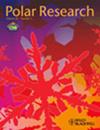Wildfires in the Campanian of James Ross Island: a new macro-charcoal record for the Antarctic Peninsula
IF 1.9
4区 地球科学
Q3 ECOLOGY
引用次数: 4
Abstract
The Cretaceous “high-fire” period was a global event that reached almost all continental masses during that period in Earth’s history. The extensive wildfires directly affected plant communities. Significant palaeobotanical records in the Antarctic Peninsula have been studied from the James Ross Sub-Basin, especially from the Santa Marta Formation. However, there is no described evidence for palaeo-wildfires in the area so far. Here, we present the first occurrence of fossilized macro-charcoal coming from James Ross Island, confirming that palaeo-wildfires occurred in the Campanian vegetation preserved in the Santa Marta Formation. The new charcoal material has a gymnospermous taxonomic affinity, more specifically with the Araucariaceae, which is in accordance with previous palaeobotanical records from James Ross Island. This occurrence adds new information to the construction of the palaeo-wildfire scenario for Gondwana.詹姆斯罗斯岛坎帕尼亚的野火:南极半岛新的宏观木炭记录
白垩纪的“大火”时期是一个全球性的事件,在地球历史上的这一时期,几乎所有的大陆块都受到了影响。大范围的野火直接影响了植物群落。南极半岛詹姆斯罗斯亚盆地,特别是圣玛尔塔组的重要古植物学记录已被研究。然而,到目前为止,该地区还没有描述过古野火的证据。在这里,我们首次发现了来自詹姆斯罗斯岛的大型木炭化石,证实了古野火发生在圣玛尔塔组保存的坎帕尼亚植被中。新的木炭材料在分类上具有裸子植物的亲缘关系,更具体地说是与Araucariaceae的亲缘关系,这与詹姆斯罗斯岛以前的古植物学记录一致。这一事件为冈瓦纳古野火情景的构建提供了新的信息。
本文章由计算机程序翻译,如有差异,请以英文原文为准。
求助全文
约1分钟内获得全文
求助全文
来源期刊

Polar Research
地学-地球科学综合
CiteScore
3.20
自引率
5.30%
发文量
22
审稿时长
>12 weeks
期刊介绍:
Since 1982, Polar Research has been the international, peer-reviewed journal of the Norwegian Polar Institute, Norway''s central institution for research, environmental monitoring and mapping of the polar regions. Aiming to promote the exchange of scientific knowledge about the Arctic and Antarctic across disciplinary boundaries, Polar Research serves an international community of researchers and managers. As an open-access journal, Polar Research makes its contents freely available to the general public.
Original primary research papers comprise the mainstay of Polar Research. Review articles, brief research notes, letters to the editor and book reviews are also included. Special issues are published from time to time.
The scope of Polar Research encompasses research in all scientific disciplines relevant to the polar regions. These include, but are not limited to, the subfields of biology, ecology, geology, oceanography, glaciology and atmospheric science. Submissions from the social sciences and those focusing on polar management and policy issues are welcome. Contributions about Antarctica are particularly encouraged.
 求助内容:
求助内容: 应助结果提醒方式:
应助结果提醒方式:


